Test your preparation for Microsoft 70-457 with these actual 70-457 questions below. Exam questions are a sure method to validate one’s preparation for actual certification exam.
QUESTION 1
You develop a Microsoft SQL Server 2012 server database that supports an application.
The application contains a table that has the following definition:
CREATE TABLE Inventory
(ItemID int NOT NULL PRIMARY KEY,
ItemsInStore int NOT NULL,
ItemsInWarehouse int NOT NULL)
You need to create a computed column that returns the sum total of the ItemsInStore and ItemsInWarehouse values for each row.
Which Transact-SQL statement should you use?
A. ALTER TABLE InventoryADD TotalItems AS ItemsInStore + ItemsInWarehouse
B. ALTER TABLE InventoryADD ItemsInStore – ItemsInWarehouse = TotalItems
C. ALTER TABLE InventoryADD TotalItems = ItemsInStore + ItemsInWarehouse
D. ALTER TABLE InventoryADD TotalItems AS SUM(ItemsInStore, ItemslnWarehouse);
Answer: A
Explanation:
http://technet.microsoft.com/en-us/library/ms190273.aspx
QUESTION 2
You develop a Microsoft SQL Server 2012 database.
You create a view from the Orders and OrderDetails tables by using the following definition.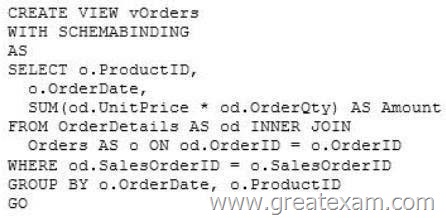
You need to improve the performance of the view by persisting data to disk.
What should you do?
A. Create an INSTEAD OF trigger on the view.
B. Create an AFTER trigger on the view.
C. Modify the view to use the WITH VIEW_METADATA clause.
D. Create a clustered index on the view.
Answer: D
Explanation:
http://msdn.microsoft.com/en-us/library/ms188783.aspx
QUESTION 3
You develop a database for a travel application.
You need to design tables and other database objects.
You create the Airline_Schedules table.
You need to store the departure and arrival dates and times of flights along with time zone information.
What should you do?
A. Use the CAST function.
B. Use the DATE data type.
C. Use the FORMAT function.
D. Use an appropriate collation.
E. Use a user-defined table type.
F. Use the VARBINARY data type.
G. Use the DATETIME data type.
H. Use the DATETIME2 data type.
I. Use the DATETIMEOFFSET data type.
J. Use the TODATETIMEOFFSET function.
Answer: I
Explanation:
http://msdn.microsoft.com/en-us/library/ff848733.aspx
http://msdn.microsoft.com/en-us/library/bb630289.aspx
QUESTION 4
You develop a database for a travel application.
You need to design tables and other database objects.
You create a stored procedure.
You need to supply the stored procedure with multiple event names and their dates as parameters.
What should you do?
A. Use the CAST function.
B. Use the DATE data type.
C. Use the FORMAT function.
D. Use an appropriate collation.
E. Use a user-defined table type.
F. Use the VARBINARY data type.
G. Use the DATETIME data type.
H. Use the DATETIME2 data type.
I. Use the DATETIMEOFFSET data type.
J. Use the TODATETIMEOFFSET function.
Answer: E
QUESTION 5
You have a view that was created by using the following code: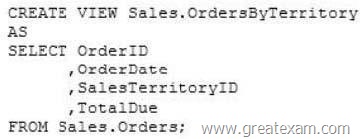
You need to create an inline table-valued function named Sales.fn_OrdersByTerritory, which must meet the following requirements:
– Accept the @T integer parameter.
– Use one-part names to reference columns.
– Filter the query results by SalesTerritoryID.
– Return the columns in the same order as the order used in OrdersByTerritoryView.
Which code segment should you use? To answer, type the correct code in the answer area.
Answer:
CREATE FUNCTION Sales.fn_OrdersByTerritory (@T int)
RETURNS TABLE
AS
RETURN
(
SELECT OrderID,OrderDate,SalesTerrirotyID,TotalDue
FROM Sales.OrdersByTerritory
WHERE SalesTerritoryID = @T
)
QUESTION 6
You have a database that contains the tables shown in the exhibit. (Click the Exhibit button.)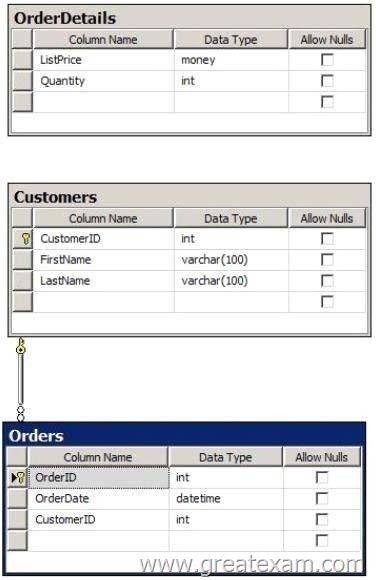
You deploy a new server that has SQL Server 2012 installed.
You need to create a table named Sales.OrderDetails on the new server.
Sales.OrderDetails must meet the following requirements:
– Write the results to a disk.
– Contain a new column named LineItemTotal that stores the product of ListPrice and Quantity for each row.
– The code must NOT use any object delimiters.
The solution must ensure that LineItemTotal is stored as the last column in the table.
Which code segment should you use? To answer, type the correct code in the answer area.
Answer:
CREATE TABLE Sales.OrderDetails (
ListPrice money not null,
Quantity int not null,
LineItemTotal as (ListPrice – Quantity) PERSISTED)
Explanation:
http://msdn.microsoft.com/en-us/library/ms174979.aspx
http://technet.microsoft.com/en-us/library/ms188300.aspx
QUESTION 7
You have a database that contains the tables shown in the exhibit. (Click the Exhibit button.)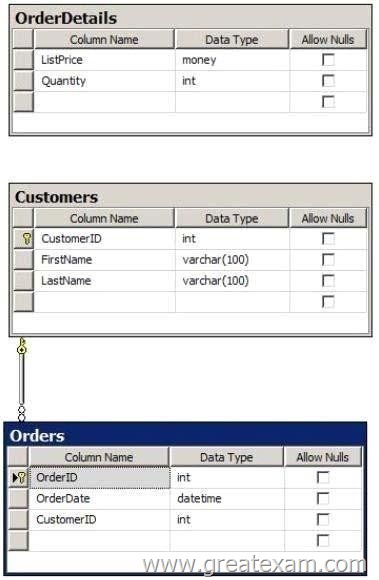
You need to create a view named uv_CustomerFullName to meet the following requirements:
– The code must NOT include object delimiters.
– The view must be created in the Sales schema.
– Columns must only be referenced by using one-part names.
– The view must return the first name and the last name of all customers.
– The view must prevent the underlying structure of the customer table from being changed.
– The view must be able to resolve all referenced objects, regardless of the user’s default schema.
Which code segment should you use? To answer, type the correct code in the answer area.
Answer:
CREATE VIEW Sales.uv_CustomerFullName
WITH SCHEMABINDING
AS
SELECT FirstName, LastName
FROM Sales.Customers
Explanation:
http://msdn.microsoft.com/en-us/library/ms187956.aspx
QUESTION 8
You have a database that contains the tables shown in the exhibit. (Click the Exhibit button.)
You need to create a query that calculates the total sales of each OrderId from the Sales.Details table. The solution must meet the following requirements:
– Use one-part names to reference columns.
– Start the order of the results from OrderId.
– NOT depend on the default schema of a user.
– Use an alias of TotalSales for the calculated ExtendedAmount.
– Display only the OrderId column and the calculated TotalSales column.
Which code segment should you use? To answer, type the correct code in the answer area.
Answer:
SELECT OrderID, SUM(ExtendedAmount) AS TotalSales
FROM Sales.Details
GROUP BY OrderID
ORDER BY OrderID
QUESTION 9
You develop a Microsoft SQL Server 2012 database that contains tables named Customers and Orders. The tables are related by a column named CustomerId.
You need to create a query that meets the following requirements:
– Returns the CustomerName for all customers and the OrderDate for any orders that they have placed.
– Results must not include customers who have not placed any orders.
Which Transact-SQL query should you use?
A. SELECT CustomerName, OrderDateFROM CustomersLEFT OUTER JOIN OrdersON Customers.CuscomerlD = Orders.CustomerId
B. SELECT CustomerName, OrderDateFROM CustomersRIGHT OUTER JOIN OrdersON Customers.CustomerID = Orders.CustomerId
C. SELECT CustomerName, OrderDateFROM CustomersCROSS JOIN OrdersON Customers.CustomerId = Orders.CustomerId
D. SELECT CustomerName, OrderDateFROM CustomersJOIN OrdersON Customers.CustomerId = Orders.CustomerId
Answer: D
Explanation:
http://msdn.microsoft.com/en-us/library/ms177634.aspx
QUESTION 10
You create a stored procedure that will update multiple tables within a transaction.
You need to ensure that if the stored procedure raises a run-time error, the entire transaction is terminated and rolled back.
Which Transact-SQL statement should you include at the beginning of the stored procedure?
A. SET XACT_ABORT ON
B. SET ARITHABORT ON
C. TRY
D. BEGIN
E. SET ARITHABORT OFF
F. SET XACT_ABORT OFF
Answer: A
Explanation:
http://msdn.microsoft.com/en-us/library/ms190306.aspx
http://msdn.microsoft.com/en-us/library/ms188792.aspx
QUESTION 11
Your database contains two tables named DomesticSalesOrders and InternationalSalesOrders. Both tables contain more than 100 million rows. Each table has a Primary Key column named SalesOrderId. The data in the two tables is distinct from one another. Business users want a report that includes aggregate information about the total number of global sales and total sales amounts.
You need to ensure that your query executes in the minimum possible time.
Which query should you use?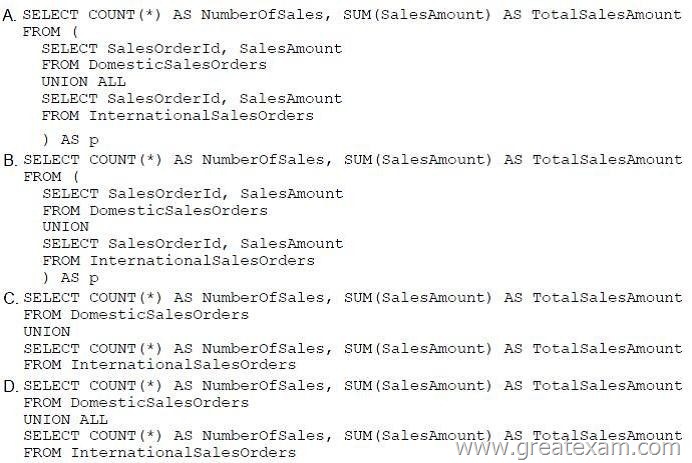
A. Option A
B. Option B
C. Option C
D. Option D
Answer: A
Explanation:
http://msdn.microsoft.com/en-us/library/ms180026.aspx
http://blog.sqlauthority.com/2009/03/11/sql-server-difference-between-union-vs-union-all-
optimal-performance-comparison/
QUESTION 12
You use a Microsoft SQL Server 2012 database.
You want to create a table to store Microsoft Word documents.
You need to ensure that the documents must only be accessible via Transact-SQL queries. Which Transact-SQL statement should you use?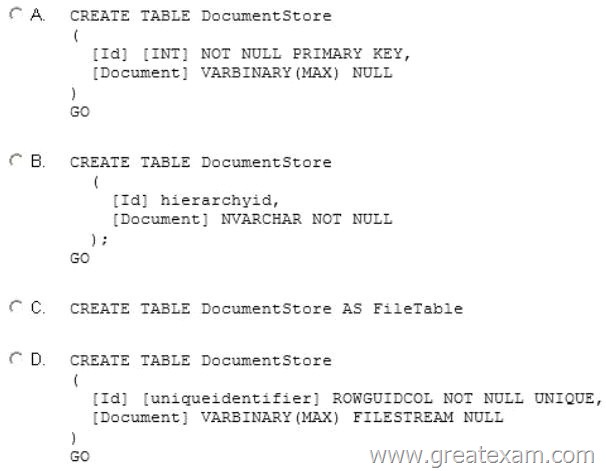
A. Option A
B. Option B
C. Option C
D. Option D
Answer: A
Explanation:
http://msdn.microsoft.com/en-us/library/gg471497.aspx
http://msdn.microsoft.com/en-us/library/ff929144.aspx
QUESTION 13
You are a database developer at an independent software vendor.
You create stored procedures that contain proprietary code.
You need to protect the code from being viewed by your customers.
Which stored procedure option should you use?
A. ENCRYPTBYKEY
B. ENCRYPTION
C. ENCRYPTBYPASSPHRASE
D. ENCRYPTBYCERT
Answer: B
Explanation:
http://technet.microsoft.com/en-us/library/bb510663.aspx
http://technet.microsoft.com/en-us/library/ms174361.aspx
http://msdn.microsoft.com/en-us/library/ms187926.aspx
http://technet.microsoft.com/en-us/library/ms190357.aspx
http://technet.microsoft.com/en-us/library/ms188061.aspx
QUESTION 14
You administer a Microsoft SQL Server 2012 database that contains a table named OrderDetail. You discover that the
NCI_OrderDetail_CustomerID non-clustered index is fragmented.
You need to reduce fragmentation.
You need to achieve this goal without taking the index offline.
Which Transact-SQL batch should you use?
A. CREATE INDEX NCI_OrderDetail_CustomerID ON OrderDetail.CustomerID WITH DROP EXISTING
B. ALTER INDEX NCI_OrderDetail_CustomerID ON OrderDetail.CustomerID REORGANIZE
C. ALTER INDEX ALL ON OrderDetail REBUILD
D. ALTER INDEX NCI_OrderDetail_CustomerID ON OrderDetail.CustomerID REBUILD
Answer: B
Explanation:
http://msdn.microsoft.com/en-us/library/ms188388.aspx
QUESTION 15
You develop a Microsoft SQL Server 2012 database.
The database is used by two web applications that access a table named Products.
You want to create an object that will prevent the applications from accessing the table directly while still providing access to the required data.
You need to ensure that the following requirements are met:
– Future modifications to the table definition will not affect the applications’ ability to access data.
– The new object can accommodate data retrieval and data modification.
You need to achieve this goal by using the minimum amount of changes to the applications.
What should you create for each application?
A. Synonyms
B. Common table expressions
C. Views
D. Temporary tables
Answer: C
Explanation:
http://msdn.microsoft.com/en-us/library/ms190174.aspx
QUESTION 16
You develop a Microsoft SQL Server 2012 database.
You need to create a batch process that meets the following requirements:
– Returns a result set based on supplied parameters.
– Enables the returned result set to perform a join with a table.
Which object should you use?
A. Inline user-defined function
B. Stored procedure
C. Table-valued user-defined function
D. Scalar user-defined function
Answer: C
QUESTION 17
You develop a Microsoft SQL Server 2012 database that contains a heap named OrdersHistoncal.
You write the following Transact-SQL query:
INSERT INTO OrdersHistorical
SELECT – FROM CompletedOrders
You need to optimize transaction logging and locking for the statement.
Which table hint should you use?
A. HOLDLOCK
B. ROWLOCK
C. XLOCK
D. UPDLOCK
E. TABLOCK
Answer: E
Explanation:
http://technet.microsoft.com/en-us/library/ms189857.aspx
http://msdn.microsoft.com/en-us/library/ms187373.aspx
QUESTION 18
You develop a Microsoft SQL Server 2012 database.
You need to create and call a stored procedure that meets the following requirements:
– Accepts a single input parameter for CustomerID.
– Returns a single integer to the calling application.
Which Transact-SQL statement or statements should you use? (Each correct answer presents part of the solution. Choose all that apply.)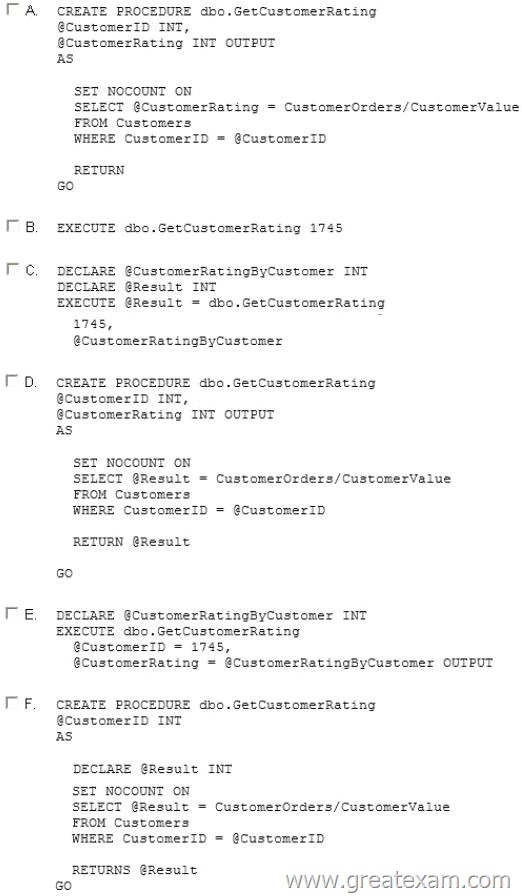
A. Option A
B. Option B
C. Option C
D. Option D
E. Option E
F. Option F
Answer: CF
QUESTION 19
You use a Microsoft SQL Server 2012 database that contains two tables named SalesOrderHeader and SalesOrderDetail.
The indexes on the tables are as shown in the exhibit. (Click the Exhibit button.)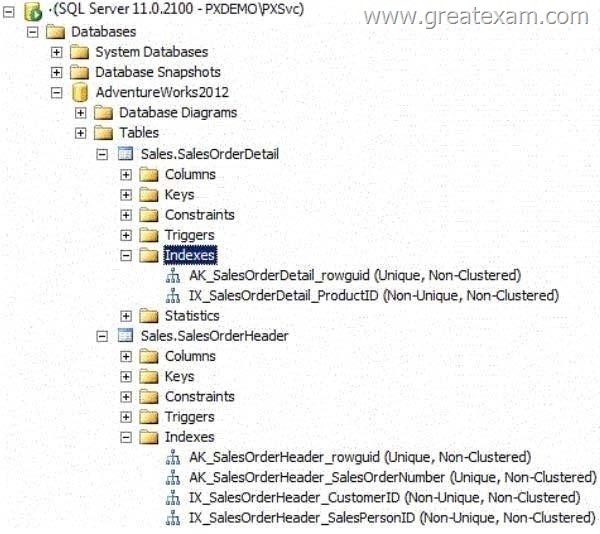
You write the following Transact-SQL query:
You discover that the performance of the query is slow.
Analysis of the query plan shows table scans where the estimated rows do not match the actual rows for SalesOrderHeader by using an unexpected index on SalesOrderDetail.
You need to improve the performance of the query.
What should you do?
A. Use a FORCESCAN hint in the query.
B. Add a clustered index on SalesOrderId in SalesOrderHeader.
C. Use a FORCESEEK hint in the query.
D. Update statistics on SalesOrderId on both tables.
Answer: D
Explanation:
http://msdn.microsoft.com/en-us/library/ms187348.aspx
QUESTION 20
Your database contains a table named Purchases. The table includes a DATETIME column named PurchaseTime that stores the date and time each purchase is made. There is a non-clustered index on the PurchaseTime column. The business team wants a report that displays the total number of purchases made on the current day.
You need to write a query that will return the correct results in the most efficient manner.
Which Transact-SQL query should you use?
A. SELECT COUNT(*)
FROM Purchases
WHERE PurchaseTime = CONVERT(DATE, GETDATE())
B. SELECT COUNT(*)
FROM Purchases
WHERE PurchaseTime = GETDATE()
C. SELECT COUNT(*)
FROM Purchases
WHERE CONVERT(VARCHAR, PurchaseTime, 112) = CONVERT(VARCHAR, GETDATE(), 112)
D. SELECT COUNT(*)
FROM Purchases
WHERE PurchaseTime >= CONVERT(DATE, GETDATE())
AND PurchaseTime < DATEADD(DAY, 1, CONVERT(DATE, GETDATE()))
Answer: D
Explanation:
Two answers will return the correct results (the “WHERE CONVERT…” and “WHERE …
AND … ” answers).
The correct answer for Microsoft would be the answer that is most “efficient”.
Anybody have a clue as to which is most efficient?
In the execution plan, the one that I’ve selected as the correct answer is the query with the shortest duration. Also, the query answer with “WHERE
CONVERT…” threw warnings in the execution plan… something about affecting CardinalityEstimate and SeekPlan.
http://technet.microsoft.com/en-us/library/ms181034.aspx
These Microsoft 70-457 exam questions are all a small selection of questions. If you want to practice more questions for actual 70-457 exam, use the links at the end of this document. Also you can find links for 70-457 exam practice test software that is great for preparation and self-assessment for Microsoft 70-457 exam.